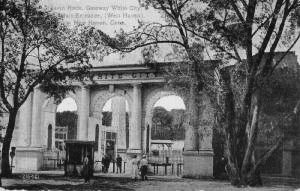
Remembering Savin Rock
Part II
See part 1 here.
See part 3 here.
In 1869-1870, George Kelsey built a 1500 foot pier off of Beach Street and inaugurated ferry service to both New Haven and the Lighthouse. He then built the Seaview Hotel, the famous bandstand and fountain at Savin Rock, and the Observatory atop Savin Rock. Clearly, Kelsey changed both the landscape and economy of our community—and became quite wealthy in the process. It seems quite appropriate therefore that one of the main thoroughfares leading to Savin Rock is named in his honor.
As Kelsey prepared the infrastructure, others would eventually expand Savin Rock’s recreational offerings: the sandy beach at Savin Rock provided opportunities for the citizens of the community as well as visitors who bathed, dug clams, or fished for harbor bluefish. The Grove, just east of Savin Rock, was the scene of many picnics, camping expeditions, and reunions, but it was not until the 1870’s that a mechanical concession was first erected on this natural playground. The first “flying horses” were operated in 1878; they were powered by a man pulling a rope. Later, power for the flying horses was provided by a horse walking on a treadmill, which was connected to the carousel by a leather drive belt. The horse, as the story goes, had a fondness for chewing tobacco.
By 1875, Savin Rock was the place to go for cock fights, horse races and prize fights. A 40 foot tower on top of Savin Rock was used as an observatory until it burned in 1897. Summer crowds of up to 50,000 visited Savin Rock on weekends.
In the closing years of the 1800s, although West Haven had lost its previous importance as a shipbuilding center, it retained its supremacy as a seaside resort. The growth of Savin Rock at this time was phenomenal. The leading restaurant, bath house and pier in Savin Rock were run by a concessionaire named Skeele. The favorite foods of visitors to the Rock were clam chowder and roasted clams; indeed, Savin Rock did much to popularize the “shore dinner”. The local citizens of this period made regular summer pilgrimages, just as the Quinnipiac Indians had come there years before “to salt”.
In 1892, Savin Rock was electrified, and visitors were awed by the wondrous displays of the newfangled light bulbs and electric fountains there. In that same year, the last of the horse-drawn streetcars to serve Savin Rock went to the barn, and the clanging electric-powered trolleys took their place. These electric trolleys covered the distance from New Haven Green to Savin Rock in a mere thirty minutes—at blazing speeds which fairly terrified the passengers!
By 1899, weekly entertainment at Savin Rock included visiting vaudeville acts, minstrel shows, novelty shows and comedy acts.
To be continued.